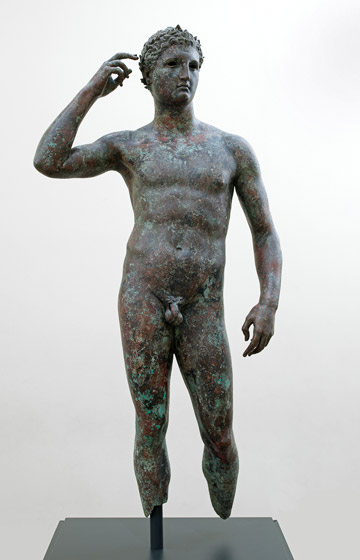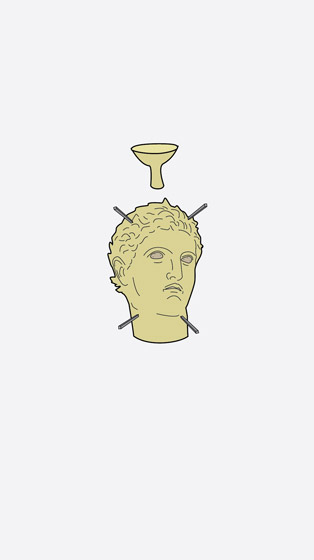Casting Bronze Statues in Ancient Greece

Victorious Athlete ("The Getty Bronze") 300 – 100 BC; bronze and copper. Lent by the J. Paul Getty Museum, Villa Collection, Malibu
The bronze sculptures in this exhibition were created by indirect lost-wax casting, a method that allowed one or more versions of a bronze to be made from a single original model. This method produced hollow bronzes with thin walls, which allowed larger statues to be produced, improved the quality of the casts, and reduced the amount of the metal required.

1. A model, probably of clay, was sculpted in the form of the desired bronze statue.

2. Molds of clay or plaster were formed around the model in sections corresponding to the head, arms, torso, and legs, and then disassembled. (These piece-molds were used to prepare a wax replica of the original model; the original model was put aside and saved for future use.)

3a. The individual piece-molds were reassembled (the mold for the head is shown) and hot wax was poured inside.

3b. The mold was swirled around, coating its interior with wax to create the wax replica.

3c. The excess wax was poured out, leaving a thin layer inside the piece-mold.

4a. The interior of the wax was filled with a mixture of fine clay, sand, and fibers to form a core.

4b. The piece-mold was opened to remove the wax replica with its core.

4c. Wax was added as needed to complete the design, and the surface was finished.

5a. Short metal pins were inserted through the wax replica to hold the core in place.

5b. Wax channels were added to create passageways that would later receive the molten bronze and let gases escape.

5c. A new mold for casting was formed by encasing the wax replica in a clay mixture similar to that of the core.

6a. The casting mold appears here in cross-section, with the metal pins holding the core in place inside.

6b. The casting mold was turned upside down and heated, melting out the wax and leaving a void in the shape of a wax replica.

6c. Molten bronze was poured in, surrounding the core and filling the interior of the casting mold.

7a. Once the bronze cooled, the casting mold was broken open.

7b. The channels were cut off and the metal pins were removed.

7c. Holes left by the pins and other flaws in the surface were carefully repaired with bronze patches.

8. Separately cast parts (here the head and arms) were fused to the torso by pouring molten metal along the joints. The surface of the assembled sculpture was cleaned, chiseled, and polished. The metal surface was treated to protect it and produce the desired color.

9. Eyes were inserted that were made of glass, bone, or stone. Each eye was wrapped in a copper sheet with the edges cut to imitate eyelashes. The lips and nipples were often inlaid with reddish copper. Gilding could also be applied.